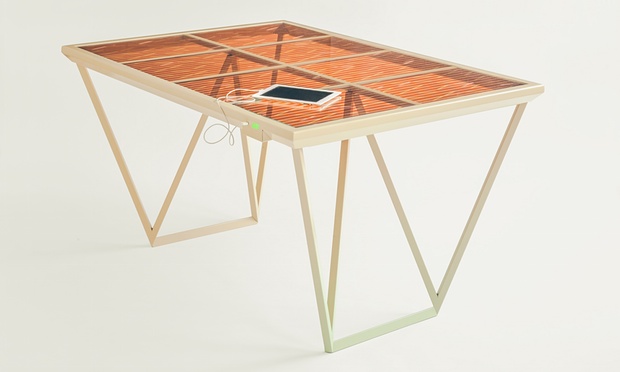Thursday, 25/12/2025 | 20:37 GMT+7
The kitchen table has been the place where many new inventions and ideas have been sketched out, but rarely has it been the source of innovation itself.
With an orange-striped surface on its steel frame, a new table from London-based designers Caventou appears to be an ultra-modern piece of furniture for an arty homeowner. A closer look reveals a port on the side where phones can be recharged using power gleaned from solar cells that cover the surface.
The table is expected to go into production next year, using solar cells that do not need direct access to sunlight.
These dye-sensitised solar cells mean that household objects, such as phones, lamps or laptops, can harvest energy from indirect sunlight and then store it later, instead of having to plug the appliances into the wall.

It is, according to creator Marjan Van Aubel, an altogether more subtle use of solar cells than planting panels on the roof. “I want to design cells that can be fully integrated into your daily life”, she said.
The solar cells used in the Caventou Current Table use a process similar to photosynthesis in plants. A dye in the cells – orange in the table – can produce energy once it is sensitised to light. A USB plug in the side means that phones can be recharged and a light plugged in, so that the table remains independent of any power source apart from itself. A network of cables runs around the perimeter of the table and the energy is stored in a battery for use at a later stage.
“I found out that colour is able to generate electricity,” Van Aubel said. “Colour is not only for aesthetics but has an extra function.”
Peter Krige, the head of technology at Caventou, said that in terms of solar cell development, the dye-sensitised cells they are using are relatively new.
For best results, the table needs to be positioned in a room with a good source of light, such as a conservatory, sunroom or kitchen. “You’ll collect the most power from the sun on bright, clear days. That being said, dye-sensitised solar panels are less affected by diffuse light levels and shadow from clouds. Although the efficiency of the solar panel will decrease in cloudy conditions, you’ll still be collecting valuable power from the sun,” Van Aubel said.Where there is less light, such as in Nordic countries at certain times of the year, there will be less energy generated, said Krige.
The first version of the Current Table has been completed and is on display in the Design Museum in London. And the next generation of the table, which is expected to start production in the new year, will be able to power both phones and laptops. “On an average day in London indoors it can power three phones and a iPad or one computer and a phone ,” Van Aubel said.
It is expected that the first consumer editions of the table will cost between £2,000 and £3,000.
Hoanguyen








 Webinar 2: “Financial Support for Energy Efficiency Enterprises – Opportunities and Challenges”
Webinar 2: “Financial Support for Energy Efficiency Enterprises – Opportunities and Challenges”
 Vietnamese enterprises achieve green growth and cut costs through energy efficiency
Vietnamese enterprises achieve green growth and cut costs through energy efficiency
 Capacity Building for Program Implementing Entity
Capacity Building for Program Implementing Entity
 Enhance Energy Efficiency Knowledge for Managers of Cement Industrial Enterprises
Enhance Energy Efficiency Knowledge for Managers of Cement Industrial Enterprises
 Capacity building for participating financial institutions of the VSUEE Project
Capacity building for participating financial institutions of the VSUEE Project
 Capacity building for participating financial institutions in Ho Chi Minh City
Capacity building for participating financial institutions in Ho Chi Minh City
 Strengthening capacity for energy management officers of local government agencies
Strengthening capacity for energy management officers of local government agencies